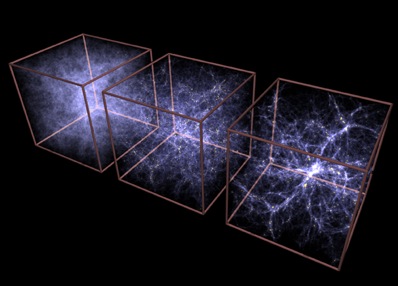|

Dark energy’s galactic stranglehold seen
BY KULVINDER SINGH CHADHA
ASTRONOMY NOW
Posted: 19 December, 2008
It dominates the Universe, accounting for 74 percent of its energy density. The mysterious, space-stretching force known as dark energy, which is accelerating the expansion of the Universe, could also be inhibiting the development of galaxies.
In a study that has taken years to complete, astronomers using the Chandra X-ray Observatory have seen that something is stifling the growth of galaxy clusters. The crucial thing about Chandra’s data is that it is independent of previous dark energy studies that have made use of supernovae. It means that there is a real phenomenon occurring that isn’t an artefact of observational techniques. Research team leader Dr Alexey Vikhlinin of the Harvard-Smithsonian Astrophysical Observatory likens the effect to an ‘arrested development’ of the Universe.

Snapshots from a simulation representing the growth of cosmic structure when the Universe was 0.9, 3.2 and 13.7 billion years old (now), from a smooth state to one with structure. Image: MPE/V.Springel.
Dark energy is in competition with the gravitational force, because unlike gravity, dark energy is repulsive. Invisible dark matter, which is known to constitute around 95 percent of the Universe’s mass, is responsible for much of this gravity. But on the largest scales dark energy appears to win out, hence the observed acceleration of an already expanding Universe (something which was well-known). But why should this repulsion inhibit the growth of galaxy clusters, the most massive collapsed objects in the Universe?
At a NASA press conference on 16 December, Vikhlinin’s colleague Dr William Forman says, “Structures [galaxy clusters] grow from very weak fluctuations present in the beginning of the Universe, and which can be seen in the Cosmic Microwave Background radiation. Gravity slows the expansion of the Universe and amplifies these very small fluctuations so that they grow to form the galaxy clusters we see so prominently in the X-ray images.” Forman adds that the scale of the new observations is around 100 million light years. This is the scale where the effect of dark energy becomes important. When the Universe entered and accelerated expansion phase eight billion years ago, the dominance of dark energy slowed structure growth significantly.

Galaxy cluster Abell 85 is one of 86 clusters observed by Chandra to trace how dark energy has stifled the growth of massive structures over the last 7 billion years. Image: SDSS/NASA/CXC/SAO/A.Vikhlinin et al.
The reason that X-ray observations are used is because the bulk of the normal mass (i.e. not dark matter) of the cluster is in the form of high-temperature, diffuse, intergalactic gas. This is straightforward to see in X-rays and has the advantage of being bright, thus observable at great distances. And this property was particularly helpful to Vikhlinin’s team. By looking at galactic clusters at different distances, Vikhlin’s team were able to observe structure growth at different epochs of the Universe’s development. What they found corroborated well with accelerating and decelerating phases in the Universe’s history.
But this is just a tentative first step towards unravelling the mystery of dark energy. Its exact nature is still a matter of speculation. Could it be the famed cosmological constant predicted by Einstein (the inherent energy of space itself)? Or, does Einstein’s Theory of General Relativity, which describes gravitation, need to be revised on these large scales? Could it be something else entirely? Will we ever truly know?
Forman ends on an upbeat note, quoting American physicist John Wheeler: “Mass tells space how to curve, and space tells mass how to behave. With supernovae data, we’ve seen how mass curves space, and with our results, we can now see how space tells matter to behave.”
|



